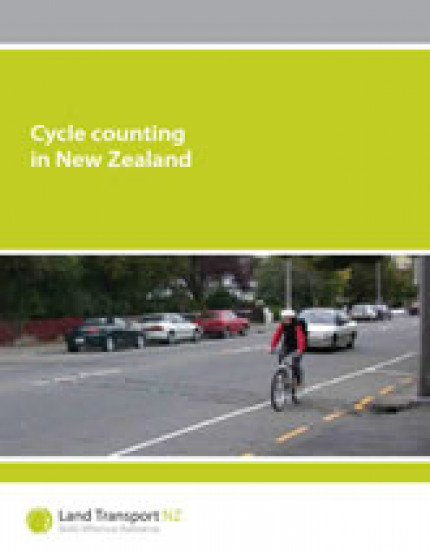Summary
This project consists of two components:
- a literature review of traffic-counting technology able to detect and monitor cycle traffic on a continuous basis
- an internet-based survey of road controlling authorities (RCAs) and regional councils about their experience and interest in counting cycle traffic, either manually or automatically.
Review of continuous cycle counting technologies
All of the products that were reviewed count cycles but many are also able to:
- record the direction of travel, speed and even position of bicycles, and/or
- distinguish between bicycles and motor vehicles and therefore be used in mixed-traffic
- situations, and/or
- distinguish between cyclists and pedestrians and therefore be appropriate for shared-use, offroad paths where the numbers of pedestrians are also required.
Most counters range in price from $3000 to $10,000.
From this limited literature review, the inductive loop products (Counters and Accessories’ Bicycle Recorder and Eco-Counter’s ZELT) appear to be the best for counting both on-road and off-road cycle traffic.
It is recommended that Land Transport New Zealand:
- obtains a Bicycle Recorder and a ZELT counter for testing in New Zealand
- commissions a pilot study of the equipment – counts should be done with both counters simultaneously in a variety of locations, including both off-road and on-road sites (the counters should be calibrated against manual counts and existing loop detectors, where feasible)
- publishes a report summarising the findings and recommending a counter or counters for use in New Zealand for continuous cycle counting, in both off-road and on-road situations.
Survey of agencies about bicycle counting experience
An excellent response rate of 71 percent was achieved for this survey. It appears that RCAs and regional councils are very interested in cycle counting.
The survey findings include the following:
- About half of the RCAs and regional councils that responded to the survey have counted cycle traffic in recent years.
- Two-thirds of those that reported counting cycle traffic use manual counts only.
- About two-thirds of respondents have cycle infrastructure projects in their forward works programmes.
- Most of the 11 agencies that count cycle traffic automatically use MetroCount 5600 or 5700 series counters.
- Half (18) of those agencies that do not count cycle traffic use MetroCount counters to count motor vehicles. These counters are capable of counting cycles. A further 12 agencies count cycle traffic manually but not automatically, although they use MetroCount counters to count motor vehicles. Thus, there are 30 agencies that could count cycles automatically with technology they already use.
- Two-thirds of the agencies that count cycle traffic have been doing so for three years or less.
- Only three agencies count (or have recently counted) cycle traffic continuously (for months or more at a time).
- Some respondents reported difficulty in getting MetroCount counters to count cycle traffic successfully, while others noted that care is needed to get reliable counts. Appendix 1 provides advice on the successful installation of MetroCount 5600 rubber tube traffic counters for counting cycles.
It is recommended that this report be made available to survey respondents by email and on the Land Transport New Zealand website.
